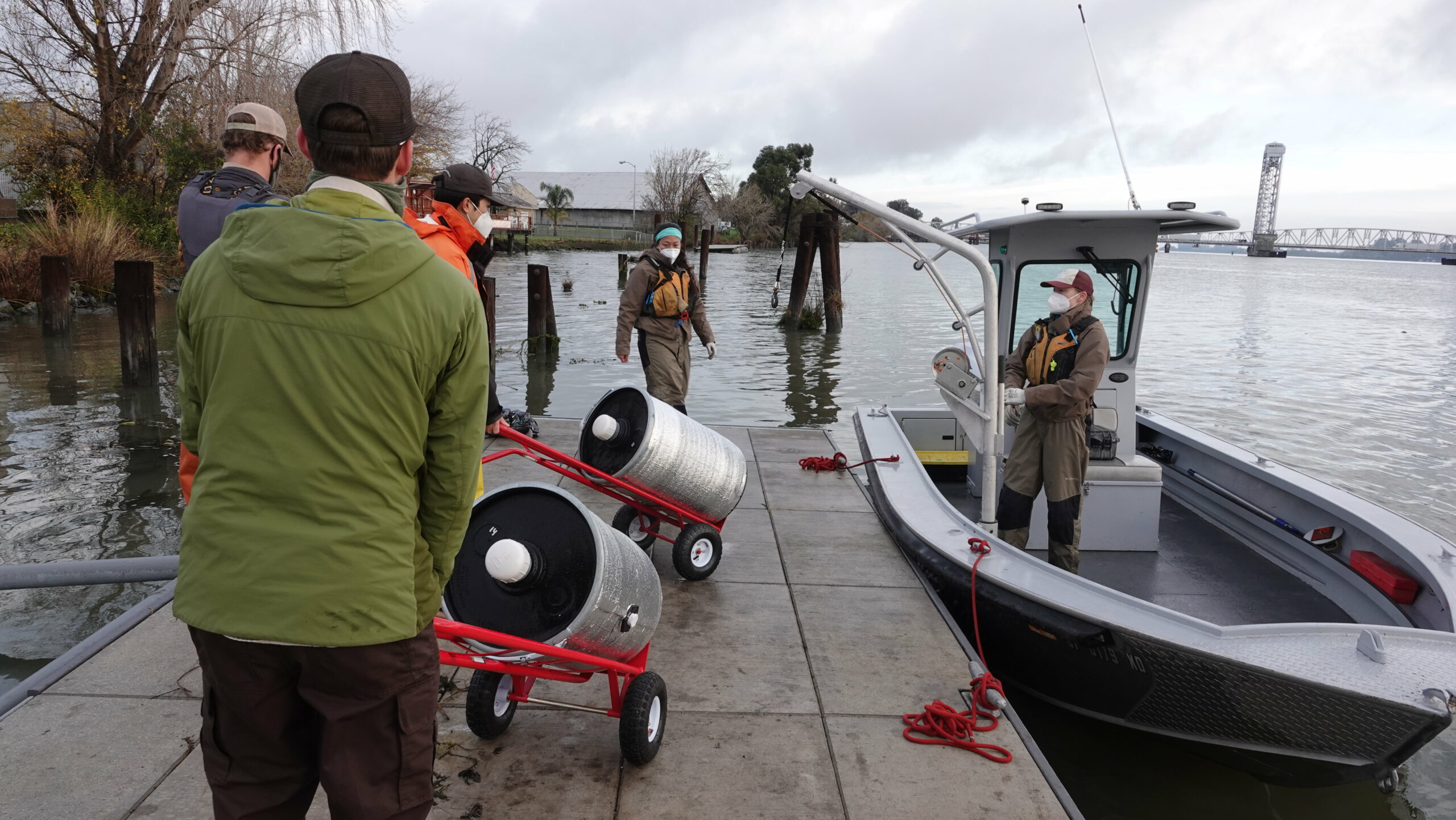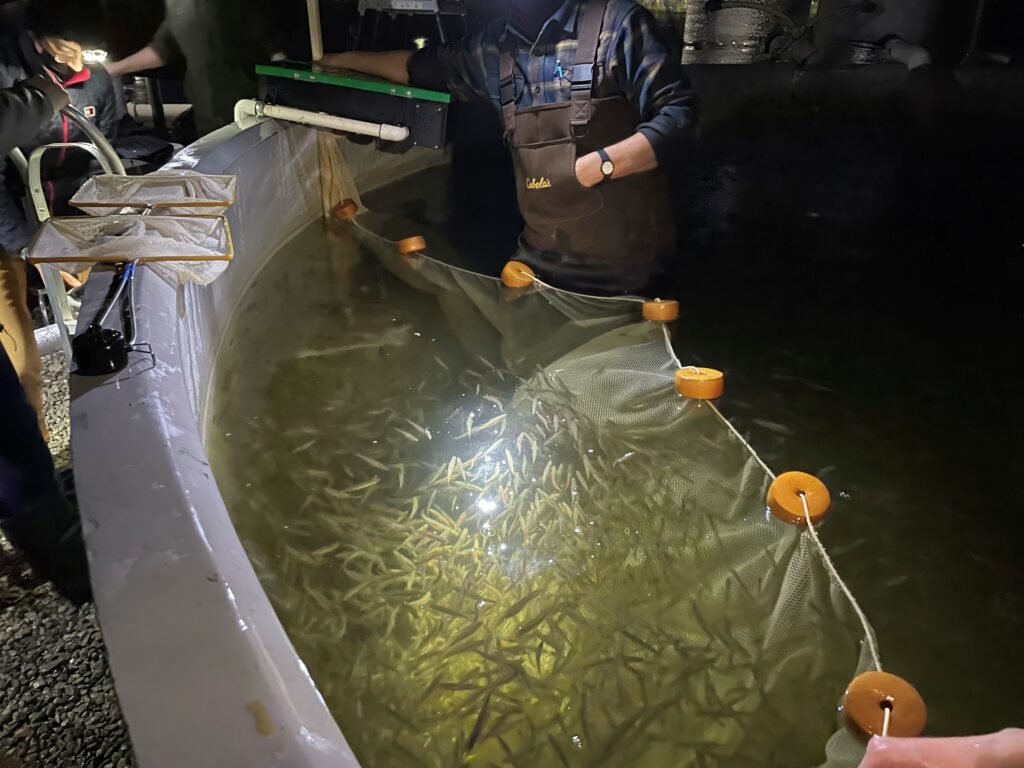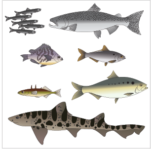
On a mild day between rainstorms in mid-December, wildlife biologists outfitted in rubber boots and orange lifejackets load drum after drum of precious cargo onto a small boat docked in Rio Vista, a town on the Sacramento River in the Sacramento-San Joaquin Delta. There is little fanfare but the occasion is nonetheless momentous. The shiny silver drums contain thousands of Delta smelt — finger-size imperiled fish unique to the Delta — that were raised in a conservation hatchery. Today marks the inaugural release of captive smelt into the cold, murky waters of their native home.
“For the first time, we’re seeing if it’s possible for hatchery-raised Delta smelt to be released into the wild, survive, and successfully reproduce,” says Katherine Sun, a biologist with the U.S. Fish and Wildlife Service (USFWS) who co-leads the multi-agency effort that also includes the California Department of Fish and Wildlife, the California Department of Water Resources, the U.S. Bureau of Reclamation, the U.S. Geological Survey, and UC Davis.
Delta smelt were once plentiful. “You could pull up a net and expect to see a good handful of them,” Sun says in a recent USFWS Fish of the Week! podcast. Added to federal and state endangered species lists in 1993, the Delta smelt is now close to extinction. “We’re talking in the hundreds,” Sun continues.

This slender, nearly translucent fish may be tiny and all but gone, yet its influence on California water is huge. Much of the water flowing through the Delta is pumped south, providing drinking water for 25 million people and irrigating nearly 4.5 million acres of Central Valley farmland. Protections for Delta smelt include periodically curtailing these exports to keep the fish from being sucked toward and even into the pumps.
“The Delta smelt … has become a flashpoint for significant resentment, frustration, and lawsuits,” note the authors of a September 2021 commentary in the journal Environmental Law Reporter, including Karrigan Börk, an associate director at the UC Davis Center for Watershed Sciences.
Tensions over the water supply could be eased by reversing the Delta smelt’s decline, giving wildlife and water managers alike a shared interest in the welfare of this at-risk species.
The immediate intent of the Rio Vista hatchery smelt release is not to bolster the barely-there wild population, but rather to determine the best way to get these captive fish into the Delta and thereby optimize future releases. It’s taken decades to get to this point.
“Some may say it’s too late but I’m glad we’re finally putting the fish out,” says Tien-Chieh Hung, who directs the UC Davis Fish Conservation and Culture Laboratory that raises hatchery smelt.
The conservation hatchery began figuring out how to breed and raise Delta smelt in captivity in the mid-1990s, soon after the fish was formally listed under the federal Endangered Species Act. To keep hatchery fish as similar to the wild population as possible, the captive population is managed to preserve genetic diversity, aided by an annual influx of up to 100 wild-caught smelt.
It’s getting hard to reach that quota. The hatchery last caught its full allotment of wild Delta smelt in the winter of 2017-2018. Over the next two winters, the catch dipped to 28 and then rebounded to 93. Last winter, the hatchery caught just two fish. “We’re struggling,” Hung says. “We’re still catching some but it takes much more effort to find them.”
The hatchery raised 40,000 smelt for this winter’s releases near Rio Vista, with 12,800 set free in the mid-December kickoff. Winter is a good time to put hatchery smelt in the wild because this is when they start migrating upstream toward the freshwater where they spawn. In summer the young smelt then migrate downstream to the brackish waters where they grow up.
Delta smelt are so sensitive to human handling that the researchers think it will take three years to figure out the best way to move and release them. For example, the team has learned that the fish need to be transported in round containers. “They’re relatively weak swimmers,” Sun explains in the podcast. “Delta smelt have been known to get stuck in corners, they get stressed out, and they die.”
This winter the researchers are comparing two ways of releasing this fragile species from the transportation drums: letting the smelt swim straight into the Delta immediately versus holding them in cages for up to three days so they can get used to their new home. The process is as gentle as possible. One by one, the drums are carefully hoisted and lowered into the water, pried opened, and gradually tipped to let Delta water in and hatchery smelt out. The small fish vanish immediately into the turbid water that helps them hide from predators.
For now, the goal is simply to see if the hatchery smelt can stay alive in the Delta. Future goals include seeing if hatchery smelt will breed in the wild, and if they can survive when released in other parts of the Delta such as the Sacramento Deep Water Ship Channel, the Cache Slough Complex, and Suisun Marsh. The eventual plan is to use hatchery Delta smelt to boost the wild population.
Hatchery fish alone will not be enough to save the smelt, however, because the Delta ecosystem is severely degraded. “Habitat restoration is a huge part of the effort,” says Ken Paglia, a California Department of Fish and Wildlife spokesman. “You don’t want to release fish into an ecosystem that isn’t doing well.”
Delta smelt require water that is cool and neither too salty nor too clear, making them dependent on freshwater from the rivers that flow into the Delta and also sensitive to the vast volumes of water exported south for drinking and irrigation. Another threat to these fish is that the Delta produces far less of the food they eat. The early 2000s saw a precipitous decline of Delta smelt that coincided with a drop in zooplankton, minuscule aquatic creatures that make perfect fish food.
Simultaneous declines were observed in several other open-water (pelagic) fish in the Delta, including the threatened longfin smelt and the non-native striped bass. This alarming multi-species decline sparked regular surveys for these pelagic fish, which serve as indicators of ecosystem health. While none of these fish have rebounded, longfin smelt are still breeding in the South Bayand striped bass are still breeding in Suisun Marsh.
Biologists hope the released hatchery Delta smelt will benefit from habitat restoration in the Delta, including tidal marshes and floodplains where zooplankton thrive. Previous experiments with captive smelt in cages in restored habitat confirm that these sites produce plenty of food for fish.
The survey crews that track Delta smelt and the other indicator pelagic fish will be able to distinguish smelt born in the hatchery from those born in the wild at a glance. The conservation hatchery marked every single one of the captive-born fish by clipping their adipose fins, small flaps on the back that don’t grow back. Some of the hatchery smelt also have silicone tags injected under their see-through skin. “It makes a one-centimeter line under the dorsal fin and you can vary the color,” Hung explains. For hatchery smelt released this winter, these subcutaneous tags are red.
Peter Moyle, a UC Davis biologist who witnessed the Delta smelt’s decline firsthand over more than half a century of studying them, is skeptical of the prospects for hatchery fish in the Delta: “If the wild smelt have not made it, what makes them think there’s good habitat now?” He also worries that hatchery smelt will lose the capacity to live in the wild. “The longer you keep them in captivity, the more domesticated they become,” he says. “We’re in a desperate situation with smelt.”
Rather than releasing hatchery smelt directly into the Delta, Moyle favors first putting them in ponds on Delta islands. This intermediate step could help captive smelt become accustomed to the natural world. That said, he agrees that taking action to save the Delta smelt is essential. “No matter what we try to do, it’s risky,” Moyle says. “But the alternative is for the smelt to go extinct.”
And there are signs of hope for hatchery smelt in the Delta. Since the first batch was let loose, survey crews have spotted more than a dozen swimming in the lower Sacramento River. “This means they weren’t just a buffet for predators and that they’re moving in the Delta,” Hung says. “They’re out there and hopefully doing well.”
Top Photo: Loading smelt for mid-channel release in December 2021. Photo: USFWS
Previous Estuary Stories
Other Links
USFWS Fish of the Week! podcast: Delta smelt featuring Katherine Sun
Revisiting the Delta Smelt: a rebuttal to Weiland and Murphy
